From Clueless to Tarantino: why the 90s was Hollywood’s fairytale decade
By
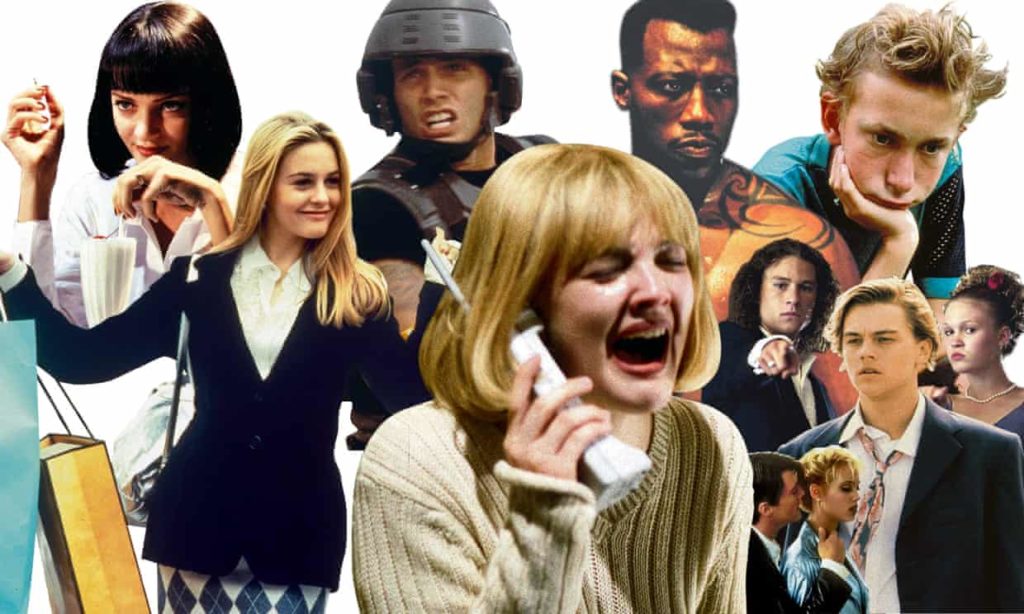
The 1990s … a simpler, more innocent time? Composite: Allstar
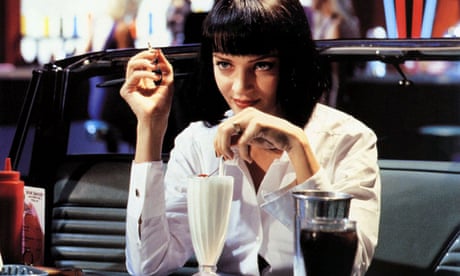
Pulp Fiction to Magnolia: the best films of the 90s – as chosen by critics
Cinema is once again mining its recent past for hits. Joel Schumacher’s 1990 medic-goth thriller Flatliners is the latest cult classic to be remade for a contemporary audience. Almost three decades on, the original – in which a group of medical students deliberately kill and then revive themselves in order to report back on the afterlife – resembles in parts a crossover episode between Buffy and Holby City. But in the shiny 2017 sequel, the gritty, steamy streets have been replaced by brightly lit high-rises, its rudimentary computers have been given an upgrade, and the astonishing amount of angular yet floppy hair sported by Kiefer Sutherland, Kevin Bacon and Billy Baldwin has been closely cropped for more austere times. Sutherland pops up in the new film, too, although the starring roles go to Ellen Page, Rogue One’s Diego Luna and Happy Valley’s James Norton. It is, so far, untainted by reviews, as it did not screen in advance for critics, which is rarely a sign of confidence in its merits.
Yet it’s unlikely to matter too much if the film is not great. As Hollywood gets increasingly caught up in reboots and remakes, Flatliners is just one of a number of 90s hits to be lined up for a do-over, with a nostalgic audience ready to revisit it. Following in Jurassic Park reboot Jurassic World’s phenomenally successful jungle footsteps is a return for the 1995 Robin Williams hit Jumanji, which has been revived for Christmas as Jumanji: Welcome to the Jungle, starring Jack Black and Dwayne “the Rock” Johnson with a retro video game in place of the board game. Tim Curry played It in 1990; the Andy Muschietti remake has already become the highest-grossing horror film of all time, a rare success in an otherwise flat summer for the box office. Over the past few years, there have been reports of development deals and scripts for remakes of everything from Sister Act to I Know What You Did Last Summer (although both projects have since gone quiet), while new versions of Blade, The Crow, The Craft and White Men Can’t Jump are said to be making progress after a few false starts.
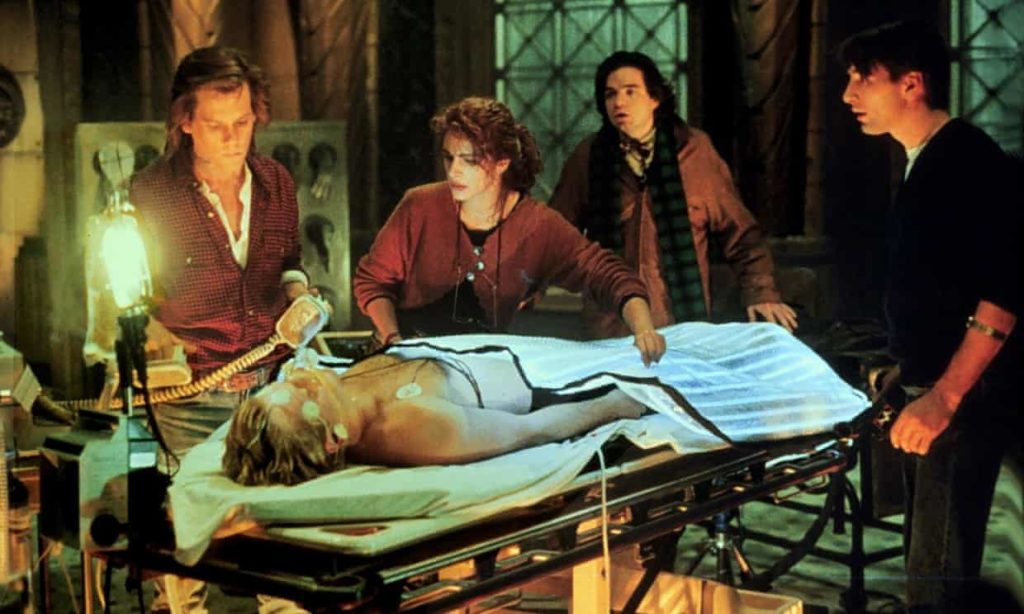
Back from the dead … Kevin Bacon, Julia Roberts, Oliver Platt, William Baldwin, Kiefer Sutherland in the original Flatliners. Photograph: Allstar/Columbia/Sportsphoto Ltd
One reason films from the 90s hold such appeal is that they seem to depict a simpler, more innocent time. “A lot of these films were written by baby boomers, so even if someone had a dead-end job, they were still able to afford accommodation, they lived in a nice neighbourhood. Even if they were struggling, their problems were quite superficial,” says Elizabeth Sankey, who worked on Beyond Clueless, a 2014 documentary about teen movies that focused heavily on the mid-to-late 90s. Sankey is currently directing a documentary about romantic comedies and has noticed a stark change in tone. “Later on, we had romcoms like Trainwreck, where the problem with the woman that needs to be fixed is that she’s an alcoholic. But in the 90s it was like, Oh, she’s really clumsy!” she says.
It’s natural, of course, to be nostalgic for the era of film-making that accompanied your adolescence, as the 90s did mine, but there is a breadth and brilliance to much of the decade’s output that is unrivalled. In this paper last year, Steve Rose described the early 90s as a “golden age” for black cinema, as film-makers such as John Singleton and Julie Dash broke through. The 90s saw the emergence of an LGBT cinema movement, with mainstream, award-winning films such as The Birdcage and Boys Don’t Cry as well as cult slow-burners such as But I’m a Cheerleader. Spike Jonze, Quentin Tarantino, Paul Thomas Anderson, David O’Russell, Noah Baumbach, Wes Anderson, Lisa Cholodenko, Alexander Payne, Lynne Ramsay, Darren Aronofsky, Sam Mendes and Todd Haynes all made their directorial feature debuts. Odd, experimental films with wild structures and often a leaning towards verbosity, such as Magnolia or Pulp Fiction or Being John Malkovich, were relatively mainstream successes.
But it wasn’t just the arrival of a particularly strong new guard that made the era special. The dominant formula of smart-but-accessible was evident across genres. There was an avalanche of glossy, skilful and lubricious trashy thrillers such as Wild Things and Single White Female, with director Paul Verhoeven in particular embodying a kind of knowing mischief that allowed him both to titillate and to tease the audience for desiring titillation. The witty smut of Basic Instinct and Showgirls have aged surprisingly well, and that is to say nothing of his sci-fi satire Starship Troopers, which he described with evident pride last year as “the most expensive art movie ever made”. (He has been less than complimentary about a mooted remake that would be less satirical, saying it would “very much fit in with a Trump presidency”.)
Like Starship Troopers, the action films released towards the end of the decade were filled with a millennial angst and political paranoia that appears both quaint, given the relatively sunny geopolitical climate of the time, and prescient. In the 2016 documentary Hypernormalisation, Adam Curtis compiles clips from Independence Day, Deep Impact, Armageddon and Godzilla of New York being terrorised or destroyed, just before he cuts to footage of 9/11.
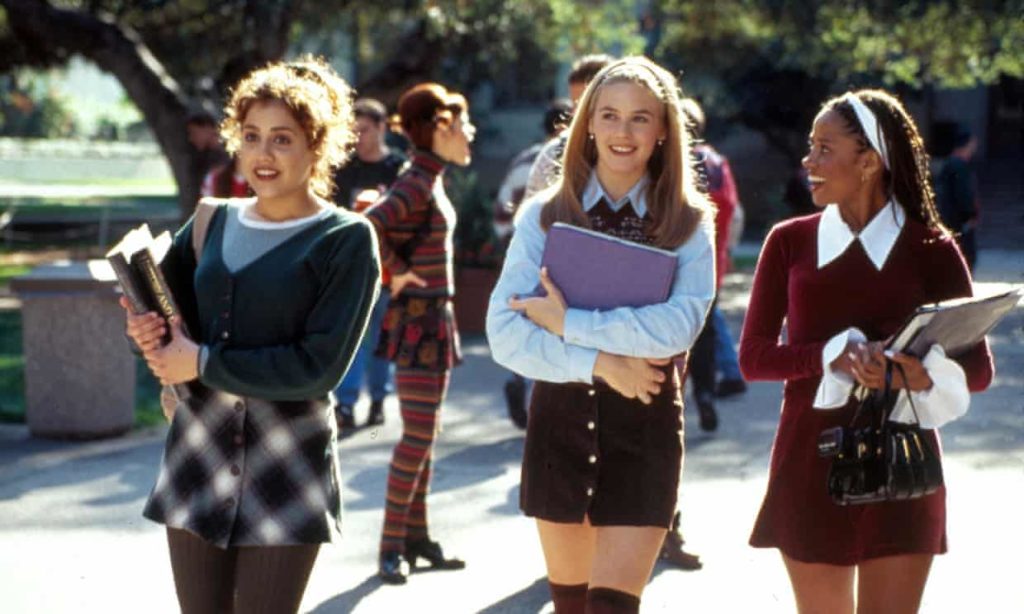
Brittany Murphy, Alicia Silverstone & Stacey Dash in Clueless. Photograph: Allstar/Paramount
Outside of big-budget action, teen movies benefited from the era’s appetite for smartness and enjoyed a boom period of the kind not seen since Judd Nelson punched the air in The Breakfast Club. High-school films excavated literary classics, rather than just older high-school films, for their plots. Famously, Clueless is based on Jane Austen’s Emma, and anyone who saw Gwyneth Paltrow in the faithful 1996 adaptation will know that Amy Heckerling’s 1995 smash, starring Alicia Silverstone, did a far better job of telling the story. She’s All That was based on Pygmalion, while 10 Things I Hate About You made The Taming of the Shrew, one of Shakespeare’s most awkwardly sexist works, into a riot grrrl-referencing feminist-ish teen classic, complete with a Joan Jett soundtrack.
With the Scream trilogy, Kevin Williamson made clever horror, using a deep awareness of the genre’s tropes and playing with the audience’s expectations of them. He bumped off the big-name star Drew Barrymore in the first few minutes for not knowing the correct answer to a quiz question about a horror film, and didn’t kill off the lead, Sydney, despite her having sex with her boyfriend, which would usually signpost imminent doom. The same meta approach is present, although to a lesser degree, in other teen horrors such as I Know What You Did Last Summer, Urban Legend and The Faculty. The Craft marked the convergence of horror and high school with Neve Campbell at the centre of the Venn diagram, and although its box office takings were disappointing, it had a long afterlife on VHS, and is responsible for more than one generation of girls dabbling in black lipstick and playing the “light as a feather, stiff as a board” sleepover game.
“I think the 90s, like any other era of cinema, is remembered for a very small pocket of its output, in the same way that the 1980s wasn’t just Back to the Future and a bunch of movies where people wore bright neon bomber jackets,” says film-maker and critic Charlie Lyne, who directed Beyond Clueless. “I’m also very wary of my own biases; that a movie that came out during the 90s is much more likely to have then been watched on VHS and cherished by a teenage-me than a film that came out before or after that, therefore you get a certain inevitable attachment that is not necessarily reflective of any objective truth.”
He does say, however, that two things happened in tandem during the 90s that he sees as significant and measurable shifts in movie history. The first is that more films were made for less money. “There is a massive lowering of the barrier to entry to make a fairly serviceable feature film. What constituted a low-budget film dropped massively during that period because of technological changes and the way the industry saw low-budget film-making, coming through festivals like Sundance. That was absolutely true in the teen genre, but also more widely, you did see an explosion in films that cost $5m and under making it to a wide audience.”
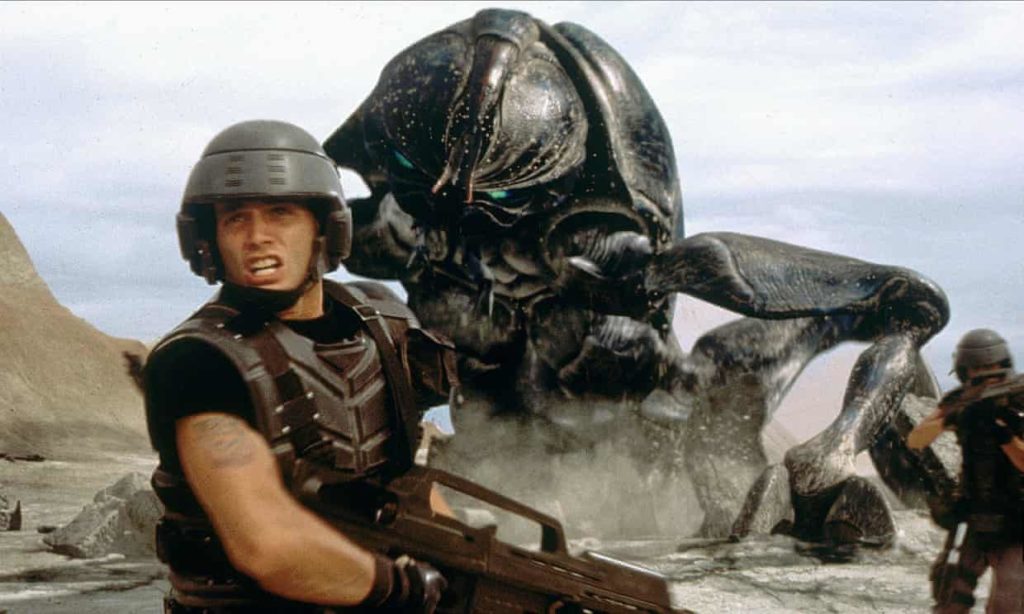
Second, there were vast improvements in home video equipment, although it was just prior to the advent of DVDs. “That had an effect on film culture and the scope of film culture – people were more able to look backwards and to a broader swath of what was coming out at the time. All of those structural changes are distinct to that decade,” he explains.
Sankey’s research for her romcom documentary has only cemented her view that the 90s were a fairytale decade. “Every single person I’ve interviewed for my film says they don’t want to get married, because they don’t have that stability in their lives. All of those things that make people feel uncomfortable about marriage are the reasons they like those films, because it felt like a much more simple, naive time.” She says that it isn’t just people who were young at the time clinging on to their halcyon days. There’s a sense of loss, too. “I think we are pining for a time we felt like we were going to get and never got. It’s a promise that was made to us by these films that we haven’t actually been able to achieve.”
Another article who’s author wrote in outline form:
Digital Age & Home Viewing
High-Cost Demanding Stars
-VCRs were popular appliances in most homes, and by the end of the decade, DVDs got more popular.
Breakthrough of Serious Themed Films and Minority Groups in the Film Industry
-Films with serious themes, such as the Holocaust, AIDS, feminism and racism, were getting bigger and featured in films such as Schindler’s List and Silence of the Lambs.
-The 1990s were a big time for super-star actors like Julia Roberts, Tom Cruise, Arnold Schwarzenegger, Robin Williams, Demi Moore, Jim Carrey, Sandra Bullock and Tom Hanks.
-African American Filmmakers were more popular in the 1990s, such as John Singleton and Spike Lee with the creation of films like Boyz N the Hood and Jungle Fever.
-Female directors were having a greater influence and showing their skills in the industry. There was also a new feminist consciousness presented through films like Thelma & Louise and Fried Green Tomatoes.
Actors Turned Directors
-Their were three actors that received numerous awards for their best pictures.
-Kevin Costner directed Dances With The Wolves (1990) and was honored with twelve nominations including Best Picture and Best Director.
-Clint Eastwood starred and directed in Unforgiven (1992), another western genre film to win Best Picture and Best Director.
-and producer/actor/director Mel Gibson’s historical Scottish film Braveheart (1995), also won Best Picture and Best Director.
Decade of Money & Mega-Spending
-Film budgets drastically increased during this decade (the average budget was $53 million, with some over $100 million).
-There was more pressure on film studios to deliver big hit movies, and good stories were lost due to making money.
-Ticket prices increased, as well more multiplexes were built.
Indie Scene
The independent films of the 1990s seemed to be made in the view of young adults in that decade making the films believable and easy to relate to for the viewers.
Disney Renaissance
Walt Disney Animation Studios (though it was called Walt Disney Feature Animations at the time,) experienced a creative resurgence in producing successful animated films based on well-known stories, which restored public and critical interest in The Walt Disney Company as a whole.
The drug culture of the 90s played a big role in many of these popular films.
The Disney Renaissance began in 1989 with The Little Mermaid, a musical that refreshed Disney’s old formulas and brought them back into the game. It reached the peak in popularity with The Lion King in 1994 a cultural landmark and height of Disney’s success. It ended in 1999 with Tarzan.
The 90s were notable for both the rise of independent cinema, but as well as Independent studios
Major studios set up specialty art-house production and distribution divisions, such as Sony Pictures Classics and Fox World Cinema, Miramax, Lions Gate and New Line.
– Jim began to make a name for himself in the film Pet Detective (1993) as a low-cost Florida detective.
Chelsea, Donovan,
Nolan & Seager
Major Blockbusters
-By the mid 1990s, many celebrities were wanting more money & better perks. Many of them wanted script/director approval, approval of publicity images, restrictions on film schedules and getting their private jets paid for.
This is also the era that began the rise of computers in animation, riding the wave of the digital revolution that brought affordable PCs to the masses in the 1980s. Disney employed CG for major parts of their films starting with The Rescuers Down Under, and by Beauty and the Beast had refined it considerably. Disney’s 1995 collaboration with Pixar brought the first all 3D movie and the one that launched into the spotlight and a position to drive the future of the animation industry: Toy Story.
The Indie Scene
Super-Stardom Of Jim Carrey
Popular independent directors such as, Richard Linklater, Kevin Smith,Todd Solondz, Gus Van Sant, Larry Clark and Jim Jarmusch, took the real life situations of people in the 90s and turned them into controversial, dark romantic comedies that were entertaining to view.
Movies from these divisions were usually low-budget and non mainstream, for the people who didn’t enjoy the “popular” films being made at the time.
– Dumb And Dumber (1994) starred Jim Carrey and Jeff Daniels as Lloyd Christmas and Harry Dunne, two not so bright buddies on a cross country road trip to Aspen. The Mask (1994), Jim had the role of a shy bank teller Stanley Ipkiss, donned an ancient, magical mask and was transformed into a green superhero.
-Carrey won the Golden Globe Best Actor award for both roles as Truman Burbank in The Truman Show (1998) and as Andy Kaufman in Man On The Moon (1999)
Many movies in the 90’s were either major flops or major hits when they hit the blockbuster, many movies that were popular were as successful as they were because of proper marketing and merchandising techniques. Also, the 90’s was largely known for having movies that featured large CGI portions, which was beginning to be popular and fans loved the ability to see something impossible to do without the help of computers.
Some major hits included:
Jurassic Park (93) Featured completely computer generated dinosaurs in live-action sequences which shocked viewers.
Forrest Gump (94)
The Lion King (94)
Independence Day (96) Grossed $100 million in the first 6 days of being released in theaters, also won the Best Visual Effects Oscar for the scene of the White house being destroyed.
Titanic (97) Major hit, grossed $600 million in the US and $1.8 billion worldwide. Had a $200 budget and won 11 Oscars.
Men in Black (97)
Plot Line Derivatives
Realizing that some ideas were being made big by fans and followers in the 90’s, Hollywood tried to take these ideas and turn them into films. Some were loved and became classics while others were met by hatred from the original fans.
Many ideas came from video games and comics, turning into films like:
The Flintstones (94)
Street Fighter(94)
Mighty Morphin Power Rangers:The Movie (95)
Inspector Gadget (99)
Flops of the 90’s
Many highly anticipated movies in the 90’s were met with high budgets to be made, yet once they hit theaters fans and critics made the movies fail terribly. Later on in the revolution of renting movies these movies made a come-back, but at the time they were flops.
Major flops with high budgets were:
Godzilla (98) CGI lizard destroying New York, fans shunned it for its version of Godzilla.
Waterworld(95) Filmed completely on water, met with a high budget yet Kevin Costner didn’t help the movies success.
Hook(91)
Highlander II: The quickening (91)